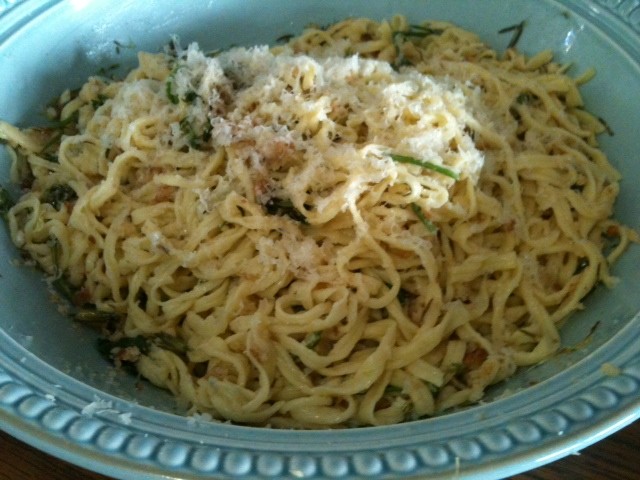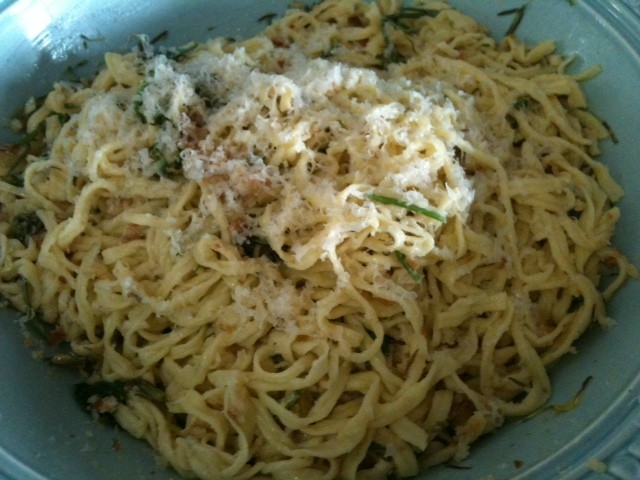
There's nothing like going to an Italian restaurant and sitting down to a plate of pasta, and there are certainly few more serendipitous moments than when the pasta arrives and it's tender, obviously house-made pasta simmered in sauce or simply tossed with oil and herbs.
There's a lot of propaganda out there about wizened old nonne practicing the craft of pasta-making with hands bent by decades of rolling gemelli and folding tortellini, and a lot of frightening warnings in cookbooks about how pasta rolling can only truly be done by professionals.
Che stronzata. LIES!
]
Of course old Zia Georgina makes great pasta after years of practice, but that doesn't mean that you have to embark on a commitment of 50 years' practice to get to where you want to be. After all, Auntie had to get her start somewhere, and I doubt there's some Magic Pasta Fairy that comes along and grants people the ability to make pasta.
Will you fail at first? Maybe. I certainly did when I started making pasta ten years ago… but what the “oh, look at this old Tuscan woman” type cookbooks don't tell you is that some failures are salvageable, even if they're not going to win any awards anytime soon for texture. Below is a good starter recipe for an almost-all-purpose egg pasta dough. You can make it into tagliatelle, you can use it for ravioli, you can use it for lasagne. There are different recipes for these doughs, and you won't be fooling any real Italians, but this one is a good starting point for learning to work with the dough.
One thing you should get is equipment. I'm not a big fan of equipment for its own sake, but I have to say the pasta roller attachment for my KitchenAid is a lifesaver. The roller itself can also be used, if you're careful, to make home batches of laminated dough (like for croissants), and the cutter attachments make it much easier to turn out of a batch of dough. If you don't have a KitchenAid, there are tabletop, hand-cranked cutters that do the exact same thing.
You CAN roll your pasta by hand with a wooden pin, and it will come out with a preternatural affinity for whatever sauce you put on it, but it will take a long time, and if you're cutting ribbons (like tagliatelle) you will get frustrated quickly when trying to make nice even knife or pizza cutter cuts.
[

Italians make pasta with a type of flour called 00 (doppio-zero), and yes, it does make a difference–but when it's available to the American home cook at all, it's very expensive. It refers to the grind size, not the protein content. For the American kitchen, start with all-purpose flour (the kind that has 3 grams of protein per pound–look at the nutrition label). Once you've gotten used to how pasta dough works, you can switch to a flour with less protein, such as White Lily.
2 cups all-purpose flour
4 egg yolks
3/4 tsp. salt
1/2 tsp. olive oil
cool water (not ice water)
1. Sift–yes, sift–the flour and salt into the largest bowl you have.
2. Stir the egg yolks and oil into the flour until the spoon gets sticky.
3. Using your hands, rub the egg yolks into the flour until it turns yellow and somewhat uniform.
4. Add water, a little bit at a time, and massage it in until the dough sticks together. It doesn't need to be uniform, just stuck together.
5. Turn it out onto a clean, floured counter, mash it into a rough ball-like shape, cover with a damp towel and let it rest for ten minutes.
6. Knead the dough on a counter for seven minutes. Add a little flour if it's so sticky it won't stay together (this means you added a little too much water, and don't worry too much about it.) Don't coddle it. After five or six minutes, it should become much smoother and much more elastic.
7. Divide the ball into four pieces and knead each piece a minute longer. They'll still be somewhat sticky, but they shouldn't tear off your hands. (If they do, re-join the balls, add flour, and knead for two minutes longer, then repeat this step.)
8. Wrap each ball in cling film and let it sit out on the counter for half an hour.
9. Flatten each ball with your hand, then roll it through the pasta machine on the lowest (“stir”) setting, twice (once in each direction) per setting, starting on setting 1. For tagliatelle, stop at setting 4. For ravioli dough, stop at 5. For angel hair (if you have such a cutter), stop at setting 7. If you're rolling by hand, roll it on a FLOURED table with a wooden rolling pin.
10. Cut with the desired cutter and, for long pasta, toss IMMEDIATELY in a bowl with plenty of flour to keep it from sticking. Some machines may require that you tear apart combined strands of, say, tagliatelle; do this after dusting heavily with flour to make it easier.
If you notice that it's too sticky going through the machine after setting 1, dust each side with a little flour (or dredge the pasta dough through a plate of flour and shake off the excess).
You can let the pasta dry (hang it over a clean railing or the backs of scrupulously cleaned chairs) or not; it is ready to cook as soon as it's come out of the cutter. If you're going to shape it, like for twisted pastas, you should let it dry for half an hour first.
Cook fresh-from-the-cutter pasta in salted boiling water for just 30 seconds to a minute, then finish it in the sauce, and don't be too careful about draining it–the pasta boiling water will tighten the sauce and cause it to cling better, no matter how bizarre the physics of that might seem at first glimpse. The picture attached to this post doesn't have a sauce, incidentally–just minced garlic, good olive oil, Romano cheese, chopped arugula flowers and some breadcrumbs.

